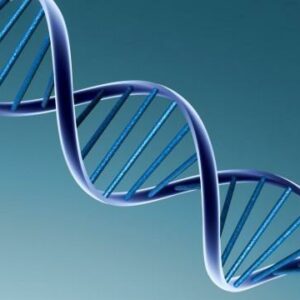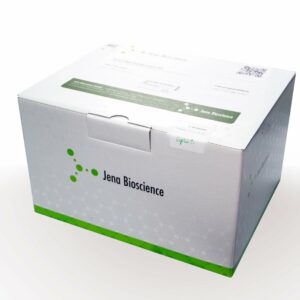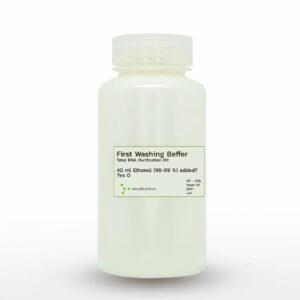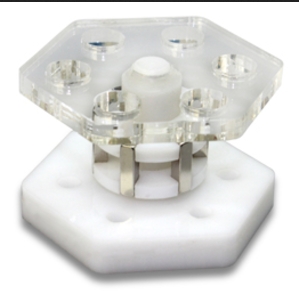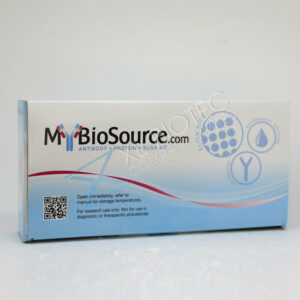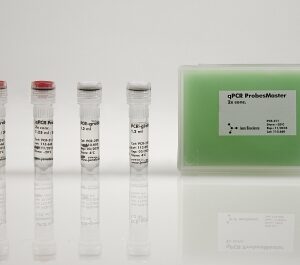For general laboratory use.
Shipping: shipped on gel packs
Storage Conditions: store at -20 °C
avoid freeze/thaw cycles
Shelf Life: 12 months after date of delivery
Description:
HighYield T7 RNAi Kit is designed to produce large amounts of double-stranded RNA (dsRNA) > 200 bp via T7 RNA Polymerase-mediated in vitro transcription. The resulting dsRNA can subsequently be used for RNA interference (RNAi) applications. Preparation of small interfering dsRNA, known as siRNA (approximately 20 bp long) is principally feasible as well however, we recommend a chemical siRNA synthesis approach for short dsRNAs.
The kit contains sufficient reagents for 50 reactions of 20 μl each (7.5 mM each NTP). A 20 μl reaction yields > 40 μg dsRNA (> 2 mg/ml) after 30 min incubation (1 μg each T7 control template I & II, 0.5 kbp RNA transcripts). Yields may however vary depending on the template (promotor design, sequence length, secondary structure formation).
Content:
HighYield T7 RNA Polymerase Mix
3x 40 μl incl. RNase inhibitor and 50 % glycerol (v/v)
HighYield T7 Reaction Buffer
1x 200 μl (10x), HEPES-based
ATP – Solution
1x 100 μl (100 mM)
GTP – Solution
1x 100 μl (100 mM)
CTP – Solution
1x 100 μl (100 mM)
UTP – Solution
1x 100 μl (100 mM)
PCR-grade water
1x 1.2 ml
DTT
1x 150 μl (100 mM)
DNase I Solution
1x 60 μl (1 u/μl)
RNase A Solution
1x 200 μl (4 mg/ml)
Sodium Acetate Solution
1x 1 ml (3 M)
T7 G-initiating control template I (0.5 kbp)
10 μl (0.5 μg/μl)
T7 G-initiating control template II (0.5 kbp)
10 μl (0.5 μg/μl)
To be provided by user
T7 Promotor-containing DNA template
Isopropanol
70 % Ethanol
Important Notes (Read before starting)
Prevention of RNAse contamination
Although a potent RNase Inhibitor is included, creating a RNAse-free work environment and maintaining RNAse-free solutions is critical for performing successful in vitro transcription reactions. We therefore recommend
- to perform all reactions in sterile, RNAse-free tubes using sterile pipette tips.
- to wear gloves when handling samples containing RNA.
- to keep all components tightly sealed both during storage and reaction procedure.
Template requirements
-
- Template type: Linearized plasmid DNA or PCR products containing a double-stranded T7 class II phi2.5 or class III phi6.5 promotor region upstream of the target sequence.Minimum T7 promotor sequences:
T7 class III phi6.5 promotor
5′-TAATACGACTCACTATAGNN…-3’
Bold: First base incorporated into RNA, NN: ideally CGor
T7 class II phi2.5 promotor
5′-TAATACGACTCACTATTANN…-3′
Bold: First base incorporated into RNA, NN: ideally GG - Template strategies:
- Template type: Linearized plasmid DNA or PCR products containing a double-stranded T7 class II phi2.5 or class III phi6.5 promotor region upstream of the target sequence.Minimum T7 promotor sequences:
Option 1:
Prepare two identical DNA templates with a single T7 promoter at opposite ends of the region to be transcribed. In vitro transcription reactions of each template can be performed to obtain complementary ssRNA molecules. An additional annealing step is required. Alternatively, transcribe both templates simultaneously in one reaction. dsRNA and unspecific aggregates are most often directly generated in this case. Aggregate formation can be solved by performing an additional denaturation and annealing step.
Option 2:
Prepare one DNA template with opposite T7 promoter at the 5′ ends of each strand. dsRNA and unspecific aggregates are most often directly generated during in vitro transcription. Aggregate formation can be solved by performing an additional denaturation and annealing step.
- Template quality: DNA template quality directly influences yield and quality of transcription reaction. Linearized plasmid DNA needs to be fully digested and to be free of contaminating RNase, protein and salts. We recommend selecting restriction enzymes that generate blunt ends or 5′-overhangs and purification by phenol/chloroform extraction. A PCR mixture can be used directly however, better yields will usually be obtained with purified PCR products (e.g. via silica-membrane based purification columns).
In vitro Transcription protocol
The protocol is optimized for 1 μg DNA template (refer to “Important Notes” regarding template requirements).
- Place HighYield T7 RNA Polymerase Mix on ice.
- Thaw all remaining components at room temperature (RT), mix by voretexing and spin down briefly.
- Assemble all components at RT to a nuclease-free microtube (sterile pipette tips) in the following order:
- Mix PCR-grade water, HighYield T7 Reaction Buffer and DTT by voretexing and spin down briefly.
- Add nucleotide solutions and template DNA, vortex and spin down briefly.
- Add HighYield T7 RNA Polymerase Mix vortex and spin down briefly.
- Incubate for 0.5h at 37°C in the dark (e.g. PCR cycler). Depending on the RNA sequence individual optimization may increase product yield (0.5h–4h at 37°C).
| Component | Volume | Final conc. |
| PCR-grade water | X μl | |
| HighYield T7 Reaction Buffer (10x) | 2 μl | 1x |
| DTT (100 mM) | 2 μl | 10 mM |
| ATP (100 mM) | 1.5 μl | 7.5 mM |
| UTP (100 mM) | 1.5 μl | 7.5 mM |
| CTP (100 mM) | 1.5 μl | 7.5 mM |
| GTP (100 mM) | 1.5 μl | 7.5 mM |
| Template DNA | X μl | 1 μg |
| HighYield T7 RNA Polymerase Mix | 2 μl | |
| Total volume | 20 μl |
Annealing/dsRNA preparation
An annealing step is recommended independent of the template strategy. Successfull annealing depends on nearly equimolar amounts of ssRNA. If ssRNA from separate in vitro transcription reactions are annealed (see „Template strategies, Option 1“), first check on transcription efficiency of each ssRNA by agarose gelelectrophoresis.
- Mix equal volumes of complementary ssRNA in case of similar transcription efficiency or adjust volume ratios accordingly.
- Incubate at 70 °C for 10 min and cool down slowly to room temperature (approximately 20 min)
- Do not place the reaction on ice. Annealing of the dsRNA occurs during cool down.
DNA template and ssRNA removal
- Dilute RNase A Solution 1:200 with PCR-grade water (prepare dilution freshly each time).
- Pipette 1 μl diluted RNase A Solution and 1 μl DNase I to 20 μl in vitro annealing reaction.
- Incubate for 30 min at 37 °C.
- Discard the diluted RNase Solution
dsRNA Purification
- Add 0.1 volume of 3 M Sodium Acetate (pH 5.2) and 1 volume of isopropanol to dsRNA reaction.
- Mix and place on ice for 5 min.
- Spin 10 min at top speed in a microcentrifuge. A white pellet should be visible.
- Carefully pipett off the supernatant and wash the pellet with 500 μl of 70 % ethanol by swiveling the reaction tube.
- Completely pipett off the ethanol and dry the pellet for 15 min with the tube open.
- Resuspend dsRNA in 2-5 fold of inital volume with PCR-grade water.
RNA quantitation
RNA concentration can be determined by absorbance measurement at 260 nm (A260) according to the Law-of-Lambert-Beer (A260 = 1 corresponds to 40 μg/ml dsRNA).
| Vendor | Jena Bioscience |
|---|
Related products
Molecular Biology
Molecular Biology
Molecular Biology
Molecular Biology
Molecular Biology
Molecular Biology
Molecular Biology
Molecular Biology


